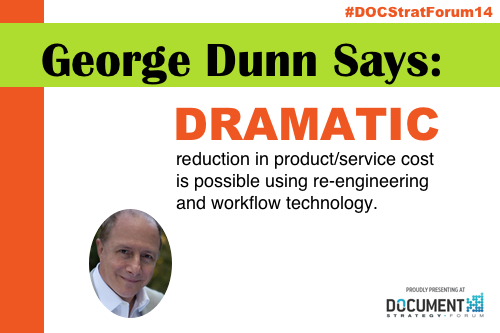
Re-engineering process improvement methodology and workflow technology, as applied to content routed in email and paper, can result in a dramatic reduction of product/service cost and non-value added steps.
What is re-engineering?
Re-engineering, according to experts Michael Hammer and James Champy, is the "fundamental rethinking and radical redesign” of business processes to achieve dramatic improvements in critical, contemporary measures of performance, such as cost, quality, service and speed.
Re-engineering starts with taking a fresh sheet of paper, forgetting about the current process, staff and systems in place, and asks: If you were starting this process today, how should it function, what are the goals of the process, should the process even exist, what leaps forward (not incremental change) are required, and what non-value process steps and structure should be eliminated to meet required improvements? Re-engineering believes that only after the organization rethinks what it should be doing does it go on to decide how best to do it.
What is workflow technology?
Workflow software provides internal and external routing of work packets, which can include: document(s), video(s), voice and related metadata (indexes). Workflow software typically includes: development tools to set up workflow patterns, maps, modeling, tasks, decisions (automatic or manual), routing (sequential or parallel), work assignment, work priority, workload rebalancing and measurement.
Case Study: Six questions to facilitate fundamental rethinking and radical redesign of an organization's email and paper processes using re-engineering and workflow.
1: What dramatic improvement is required?
Market studies show a 20% reduction of product/service cost, over the next two years, is required to keep 40% of the organization's clients. The organization has decided it is their best interest to keep these customers.
2: What is the current situation?
2: What is the current situation?
Daily, two million emails are received, 30% are deleted, 70% (1.4 million) are reviewed and placed in email folders and 490,000 are forwarded. Issues include: employees inconsistently reply, forward, maintain and delete emails/attachments; a 100,000 emails daily are printed and placed in to-do piles; between re-forwarding and replying, a single email/paper document, including attachment, can be multiplied 10 to 250 times; it is difficult to find out what has actually happened and impossible to track the status of the transaction without talking to staff; and emails are the favorite target of compliance audits, discovery, regulatory investigations and the press.
3: What leaps forward (not incremental change) are required to support dramatic improvements?
3: What leaps forward (not incremental change) are required to support dramatic improvements?
Internal email and manual processes will be replaced with workflow. Processes will be automated using structured workflow. Unstructured routing will be allowed where structured routing is not possible. Staff will be assigned to workflow tasks. Quality controls will be added. Immediate workflow tracking will be available. Organization management and measurement will shift from department/group-based to process-based.
4: Forgetting about the current process, the new process will function as follows.
4: Forgetting about the current process, the new process will function as follows.
Except for external receipt and output, routing of documents in email will be stopped. Documents will no longer internally be forwarded in paper. As needed, existing paper documents will be scanned. Work packets will be hyperlinks to content stored in electronic content management (ECM). Content will be routed through structured workflow patterns, and only when required, unstructured routing will be allowed. Approvals will be indicated within workflow and, where required, through digital signature technology. To support on-screen viewing of numerous content and data screens, employees' desks will be equipped with three side-by-side flat screens.
5: What process steps and structure will be eliminated (non-value added) to meet required improvements?
5: What process steps and structure will be eliminated (non-value added) to meet required improvements?
As result of re-engineering and workflow technology, 25% of unnecessary/unstructured email and paper process steps will be eliminated. Additional quality control routing and decision structure will be added.
6: What is the result of the organization utilizing re-engineering and workflow technology?
6: What is the result of the organization utilizing re-engineering and workflow technology?
Organizational product/service cost will be reduced by 20%, allowing the organization to keep 40% of its customers. Product/service completion time will be reduced by 37.5%. Customer service response time will be reduced by 90%. Quality controls will decrease issues with product/service, audit and litigation.
At the DOCUMENT Strategy Forum, I will share additional case study details on how re-engineering and workflow technology can provide the above benefits. For more information, visit www.DOCUMENTstrategyForum.com.
*As planning for re-engineering and workflow technology must to be tailored to the specific need of each organization the information provided in this Blog should be treated as an introduction only and, as such, without a direct consultation of requirements, CRE8 cannot assume responsibility for the use, implementation or results of information provided. This blog contains CRE8’s understanding of re-engineering and workflow technology. As there are many different definitions and books espousing re-engineering and as workflow technology abilities can change; the reader should conduct research to learn more about the specifics of the methodology and technology.















